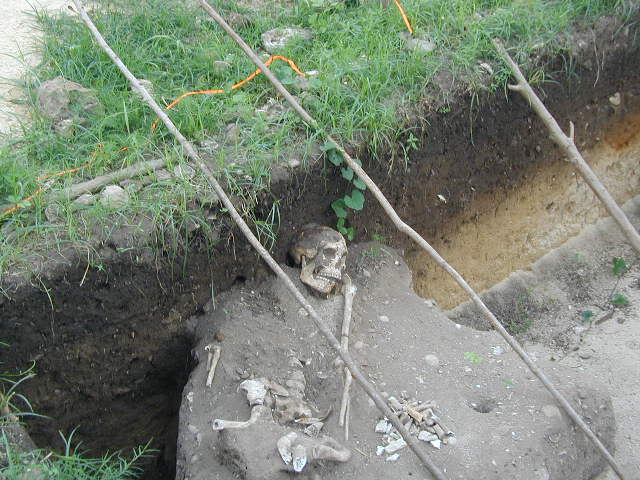
As regular readers of these travelogues have probably figured out, I attempt to use photographs when appropriate to communicate what a place or an experience is like. But I sometimes avoid taking pictures because doing so would keep me from experiencing whatever I'm there for. In this case, I took fairly few photos during the first week of the dig for that reason. I intended to take a lot more photos during the second week but circumstances (i.e. I got sick, as described below) got in the way of that. I still took several, some of which are included here, most of them taken the same evening. There were some things I considered important to include, but that I didn't manage to get good photos of. So I've supplemented my pictures with a few from other people who were there and they are credited here. Links to their photo pages are in the next chapter. I hope that's a fair solution.
I was also going to write something about the not strictly chronological structure of this section of the travelogue, but every attempt I made to do so had me screaming at myself to just get on with the bloody thing. You'll see subsections on arrival, day to day life, work, play and departure. With that explanation, I'll get on with it.
As I mentioned in the last chapter, the Hotel Mercure was the meeting point for the expedition. Earthwatch had sent a list out of volunteers, with just 3 other names and I managed to meet those three people early on Sunday morning. When everybody gathered at 10 a.m., I found out there were 3 more people who had signed up too late for their contact information to be on that list. There were also several other people including a couple of grad students from New Zealand and a professor from Texas A&M and one of his recently graduated students. We were met by Dr. Patrick Nunn (the project leader, referred to as Paddy in the rest of this account), along with Rosie (his deputy and wife), Petra (their 5-year-old daughter) and Mata (his other deputy, who is affiliated with the Fiji Museum). An hour or so project briefing seemed primarily geared towards people being afraid of the living conditions. Each of us was also given a sulu, with the project logo on it. It's proper to have your shoulders and knees covered at all times when in the village. While that's particularly true for women, the men were also expected to wear sulus over their shorts. (This applied only at the village - at the actual dig site, whatever was comfortable was the rule.)
We piled into a rented bus and Paddy's Landrover. On the way to Vusama village, we stopped in downtown Nadi at the supermarket. So my earlier shopping expedition hadn't been at all necessary, though it had been, of course, something to do.
On arrival in Vusama, at about 12:0 p.m., the first order of business was welcoming ceremonies. We took off our shoes and entered the community hall, where we all sat cross-legged in a large circle, with the village leaders facing us. Mata presented the ceremonial gift of kava root to the village headman and there was a formal exchange of what I can only assume are greetings and permissions. Kava (or yaqona) is the root of a sort of pepper plant and is very important in Fijian life. It's pounded to a powder and mixed in a large vessel with water to make a muddy, slightly soporific liquid. A bowl made from half a coconut is presented to each drinker. When you receive the bowl, you clap once, say "bula" ("cheers," the univeral Fijian greeting), drink the kava in one gulp, then clap three times in gratitude. It doesn't taste as bad as the guidebooks suggest, but I can't say that I was crazy about it either. And, you can get away with declining it after the first bowl. Some people seemed to find the kava very enjoyable, presumably because alcohol was not permitted.
Introductions followed and each of the Earthwatch volunteers was assigned a buddy from among the University of the South Pacific (abbreviated USP in the rest of this) students to help us get settled into the routine. My buddy, Amele, was a recent graduate who was going to be taking up a teaching job in a village in the Viti Levu highlands. (I should probably explain that Fiji is an island group, not just one island. Viti Levu is the largest island and where everything in this travelogue took place.) Somewhere in there, we also had lunch and met our host families, though I didn't manage to write down what order that happened in. Rachel (another volunteer) and I were assigned to the home of Sareanna and Tai (probably not spelled correctly). Our room was adequate and the family was certainly friendly and helpful.
After settling in a bit, we set off to Natadola Beach. This was said to have been rated one of the ten most beautiful beaches in the world, though nobody ever said by whom (or what the other nine are). People who rate beaches tend to go for warm water, white sand and palm trees and this had all of those. Having found myself on cold, drizzly, rocky coastlines more often than not (surprisingly frequently by choice, although once due to a typographical error at a tourist office), I'm certainly not qualified to judge.
The rest of arrival day was spent in a manner similar to our other evenings, so I might as well move into talking about day to day life. There was a nominal schedule printed in the expedition brochure, so I'll start from that and add my comments as I go along. The "typical schedule" piece is in bold face.
6:15 a.m.: Wake up, wash and dress. You don't really need quite so much time in the morning, but the odds were slim of actually sleeping as late as 6:15 unless you're a much sounder sleeper than I am. See below, under sleep. I usually found myself up by 5 and used the time to write in my journal and whine about needing more sleep. Rachel (who slept the deep sleep of the young) would add that was followed by a half hour or so of tearing my belongings apart trying to figure out where I put my watch, my hairbrush, my hair clip, etc., but I do that at home, too, despite putting things in exactly the same place every day.
7:00 a.m.: Communal breakfast in Vusama Community Hall. Probably more like 7:15 or 7:30, breakfast consisted of various bread / cake sorts of things. After the first couple of days, Paddy managed to persuade the village women that we really did want fruit, too. Apparently, fruit is considered low status food in Fiji, so that took some persuading. But it worked and bananas and papaya began to show up in the mornings. There was tea and instant coffee. Anyone who knows me knows my opinion of the latter.
8:00 a.m.: Leave Vusama to walk / drive to the field site. The major form of transportation was what is referred to locally as a carrier. This is a vehicle that I believe was designed by the chiropractic profession, with significant contributions from the manufacturers of dramamine. Take a pick-up truck, stick a couple of wooden benches into it, add a metal canopy frame to support a tarp and give people something to hold onto to keep them from being jounced through the tarp, and remove any suspension system it might ever have had. Fill with as many people as can fit, then add a few more. It's a good thing that it was a short ride to the site. Supplemented by Paddy's Landrover, it took a couple of trips to shuttle everybody to the site each morning. There is no truth to the rumor that the Federal Transportation Administration is considering importing carriers from Fiji as an alternative to funding the Metro extension to Dulles.
8:30 a.m.: Begin fieldwork. See discussion of work, below.
12:30 p.m.: Lunch and rest. We usually went down to the beach to eat lunch, which is convenient since it allows one to use the sea water for handwashing. The most frequent lunch was sandwiches (with fillings like egg or sausage), but there were some exceptions. Lying back on the sand was, in general, more appealing than the food.
1:30 p.m.: Resume fieldwork. Again, just like the morning, I will talk about the work separately.
5:30 p.m.: Finish fieldwork and leave for Vusama. I won't repeat my description of the carrier. We usually left somewhat earlier than this, probably by 5.
5:50 p.m.: Return to rooms in Vusama, wash and relax. Tea was served as soon as we got back to the village, which was more like 5:30 ish. As for washing, the main thing to keep in mind is that there isn't running water in Vusama. I can't speak to anybody else's living circumstances, but the "shower" that Rachel and I used consisted of a small wood and corrugated metal hut a little ways from the house, with a large, curtain-covered opening in the door, allowing you to see who was around. The annoying part of that was that, even though I doubted that they could see in, children often called out your name while you were washing. A couple of buckets of water awaited, along with a small container to use to pour the water over yourself. This isn't too bad for the most part, but I never felt like I could wash my hair thoroughly. On the plus side, I didn't have to worry that if Rachel washed first she would use up all the hot water since there wasn't any to start with. By the way, having clean clothes was less of an issue, as our hostess washed them every day. We paid her (FJD 15 a week each) for this service, which was well worth it.
While I am discussing lack of running water, I will briefly mention the other implication of that. A long drop toilet is not a big deal to me, but there was also the innovation of the "international toilet," located near the community hall. Well, two actually - one for men, one for women. There was the same sort of outhouse enclosure, but holding a water seal toilet, which you flush by pouring a bucket of water into it. The main advantage of this is olfactory. However, more than one person was freaked out by spiders in the toilets. At the site, the facilities were tree number three or whichever patch of high grass you favored.
7:30 p.m.: Communal dinner in Vusama Community Hall. In practice, we drifted down to the Community Hall somewhere around 7:15 and hung out either outside or just against the wall. The village men inevitably had a kava circle and several of our group chose to indulge, too. Dinner was rarely served before 8 p.m. and tended to creep later and later, to as late as 8:30. By the way, there was always a grace said before dinner, usually in Fijian. The food consisted of various starchy things (rice, breadfruit, taro, cassava) along with several dishes that ranged from fish in coconut milk to chicken in coconut milk to spinach in coconut milk to coconut in coconut milk. Okay, I am exaggerating, but coconut milk was a common ingredient. There were frequently sausages, dal (i.e. lentils), and what was called pumpkin but I suspect was some other winter squash because only Americans make that distinction. There was a wide range of levels of spiciness, too, though nothing particularly fiery.
8:30 p.m.: Team discussion and briefing in Vusama Community Hall. After dinner (so more like 9:15 or later) came the daily meeting (except Saturday night). Essentially, a representative from each pit talked about how deep they'd dug that day, what their major finds were and their plans for the next day. Paddy chose "the find of the day" earlier and announced it after the presentations. This also involved a lot of joking about various pits being disqualified and claims that Mata was seeding his pit with items smuggled from the Fiji Museum. Some nights there was an additional talk, e.g. one about stone tools ("lithics").
10:00 p.m.: Sleep. Sleep would have been nice. In one of my favorite travel books of all time, Last Chance to See, Douglas Adams has a vivid description of the noises that disrupted his sleep through the night in an Indonesian village, including cockerels, dogs, cats, and people arguing. This was a fairly similar experience. Vusama does have electricity, which means television, which was on quite a lot whether or not anybody was in the living room watching it. Roosters are alleged to crow at dawn, but the local ones (and, in fact, all others in my experience) have no idea whatsoever what time dawn is. That might not be so bad if they were at least synchronized, but I was repeatedly awakened by the 2 a.m. rooster, the 3 a.m. rooster, the 4 a.m. rooster, and so on. Dogs barked, an angry cow wandered by, a child howled with toothache, an alarm clock went off at 2:45 a.m. for no apparent reason and without seeming to have any effect on whoever it was intended to awaken. At about 4:15 in the morning, the headman walked around the village telling people what their chores for the day would be. Most of those chores seemed to involve running a weedwhacker just outside the house. Mix all that noise with a mattress that managed to have a left half that was too soft and a right half that was too hard (and no part that was just right). I know I must have gotten some sleep, but I certainly didn't feel like I had.
Another aspect of village life I should mention involves drinking water. There's a large tank at the side of the community hall for collecting rainwater. That supplemented the bottled water purchased in Nadi. While, of course, any change in what you're used to can be stressful to the body, I can't tell whether it was the water or some item of the food (along with heat and humidity and exhaustion) that resulted in my getting sick. I will spare you detailed descriptions, but let's just say that I spent a couple of days unable to retain anything I attempted to eat. Paddy took me to the hospital in Sigatoka (about 40 minutes away). The nurse didn't seem overly concerned, other than telling me I was dehydrated and needed to drink oral rehydration salts and try to eat. Dehydration was not surprising, as I had been feeling light-headed on standing up when working in the heat. Paddy persuaded her to give me antibiotics (which had worked on another person who had the same symptoms a few days earlier). That proved slightly complicated as I couldn't keep down the amoxicillin capsules she gave me, which meant I needed to wait to see the doctor. It was a long wait, allowing me to read every public health poster in the clinic a dozen or more times. When I did see the doctor, he gave me a prescription for a liquid antibiotic. Which was further complicated by my being allergic to sulfa, but that's not exactly their fault. At any rate, it was an effective solution, which certainly suggests something bacterial at work. My host probably believed that it was his insistence on praying for me that made the difference. Whatever one believes was the cause, the result was that I recovered enough to be functional (albeit not 100%) for the last few days.
Since I was there to find out what it was like working on an archaeological dig, it's about time I said something about the actual work. The first morning, Paddy gave all of us who were new a tour of the Bourewa Archeological Site. The most obvious dramatic thing to see was the skeleton that had been found before Christmas.

This was eventually going to be taken to Japan for analysis and a grad student arrived to work on all of the measuring and excavating involved in that. She was assisted by a couple of other people, giving new meaning to the term "skeleton crew." Previous excavations had uncovered other skeletons and one had been used to create a facial reconstruction of a Lapita woman. The resulting bust was exhibited to us (and to the villagers) one evening. Note that the hair is not necessarily authentic, but was added to keep from giving the impression that Lapita women were bald.

But that's all past work and there were plenty more areas at Bourewa to be excavated. Groups of about 5 or so people were assigned to work on a given pit. The one I was assigned to was led by Frank Thomas, another USP faculty member. I got along well with him, which is good since it would be annoying to work in close quarters with people you didn't like.
After laying out the pit (2 meters by 4 meters, marked with stakes and string; some pits were exploratory and as small as 1 meter by 1 meter) and putting tarps up over it to protect us from the sun, it was time to start actually digging. I should note that the tarps were only marginal protection since they had lots of tears in them. A hat, sunglasses, and SPF 50 sunscreen were essentials.
Digging is done in layers, called spits, 10 centimeters at a time. The initial spit was 20 centimeters, since this is considered to be disturbed by subsequent agriculture. That first 20 cm. is tough work, with lots of plant roots holding the earth together. All of the digging is done with hand trowels and brushes to keep from damaging any finds. The dirt gets put into buckets (using a dustpan - and, here, I had assumed that there were some exotic specialized tools involved in archaeology!) and shaken through a sieve. What's left in the sieve after the dirt is shaken out gets examined to find pottery, bones, etc. amongst the rocks and shells. Obviously, it's better if you find things while digging, rather than sieving. For those of us without any actual experience, that meant that things went quite slowly, especially at first.
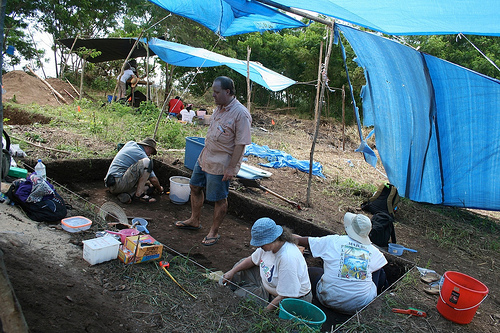
I should also mention that the digging disturbed quite a bit of local bug life. Millipedes were probably the most common. But there were also significant acts of disruption to the local ant colonies. Frank commented, "that's why I'm an ant-thropologist." The only thing that really poses any danger, though, are centipedes and those were easily enough executed by decapitating them with a trowel.
Eventually, as we dug deeper, we reached the shell midden, i.e. the layer in which the shells left over from Lapita meals are found. Among the kitchen trash is where the majority of artifacts are found. We dug up lots of potsherds, including a number of decorated ones. If I learned nothing else, I now know that "shards" are glass and "sherds" are pottery. There were two basic decoration techniques we saw on the pottery. "Paddle impressed" pottery has long lines, while "dentate-stamped" pottery has marks pricked on it, usually in circular patterns. In addition to pottery, other things to find were bones (typically fish bones, though some mammal bones), shell jewelry (e.g. highly polished rings and pieces of armbands with holes punched in them), and lithics (stone tools). The latter were a subject of considerable debate as it takes considerable expertise to decide whether a given piece of greenstone is natural or a tool. Some charcoal deposits were also collected to be used for carbon dating. Undecorated sherds smaller than a thumbnail weren't saved, but everything else was saved in plastic bags, labeled with the pit, spit, and date of collection. Really spectacular finds were bagged separately. Rosie dug up this large piece of elaborately decorated pottery, which was universally acknowledged as the best find of our couple of weeks at the Bourewa site.
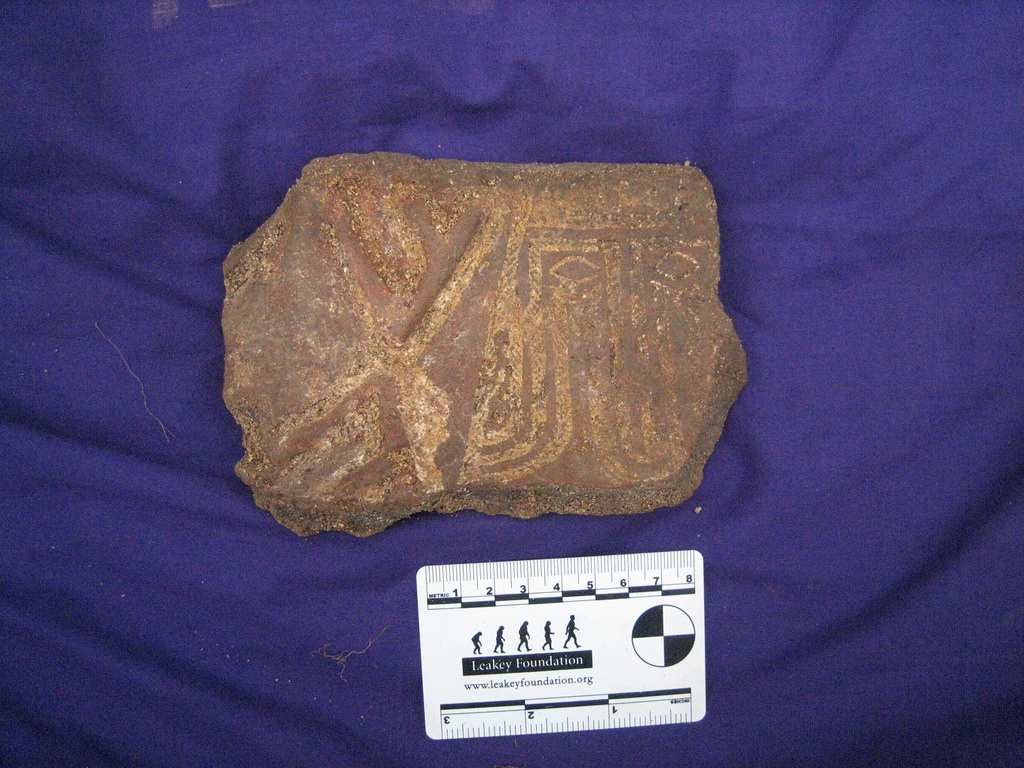
I'll write about one other incident at the site here, for lack of a better place to put it. A cyclone brushed Viti Levu on the second Friday of the expedition, with periods of rain and high winds. When we got to the site on Saturday morning, the tarps had definitely felt the effects. A few people were trying to repair ours, despite the continued high winds, and I concluded that anything I could do would just mean getting in the way of their efforts. So I went to stand and watch from the bench set up behind the shelter where we stored certain equipment during the day. All of a sudden, a gust of wind struck the shelter - and the corrugated metal pieces of the roof came flying right at me. I covered my head to protect it, so my left shoulder bore the brunt. I wasn't injured but was trapped until other people pulled the roof pieces off me. There was a more significant cyclone which struck Fiji about a week and a half later (while the next Earthwatch team was there) and I hope that they didn't go to the site under those conditions.
Back to more prosaic subjects, bringing pottery back to the village wasn't the end of dealing with it. There were a couple of days when, instead of going to dig at the site, we stayed in the village and washed pottery. This was a less cushy job than it sounds like, as one sits on blocks of concrete, bending over a bucket of water and scrubbing the pottery with a toothbrush, which is hard on the upper back and neck. We made the time pass by playing parlor games, such as naming bands starting with each letter of the alphabet. Another session of washing the next week was enlivened by a trivia game. I used a question about the bird with the longest migration (the arctic tern, of course) as an excuse to tell the shaggy dog story about the terns hitching a ride on a ship off San Francisco who got into certain contraband substances among the cargo, leaving no tern un-stoned.
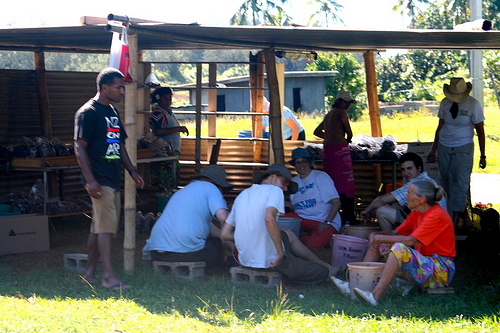
Washed pottery was laid out to dry in the sun, then sorted into four categories - undecorated sides, decorated sides, undecorated rims, and decorated rims. Then they were re-bagged and counted. The information about which pit and spit they were collected from and when was retained through all of this. Further analysis would be done back at USP and at other labs.
The normal evening routine was slightly altered on Friday and Saturday nights. While we still had a meeting on Friday night (since Saturday was a work day), it was followed by entertainment. The first week, that just meant music (from a boom box) and dancing. An invitation to dance involves a standing person tapping on the foot of a seated one, by the way. The local women came around and poured baby powder on everybody. One of the USP students explained to me that this was just something that Fijians did when they were happy and had only been practiced for the past few years. Everything apparently went on quite late, but I was too tired to stay for long. Saturday night was a bit tamer, with singing accompanied by guitar and ukulele.
Normally, everybody would be expected to go to the local church services on Sunday morning. However, the villagers were going to another village for church that week, so we were relieved of this obligation. This provided us with an opportunity to go to the Sigatoka Sand Dunes, Fiji's first national park. We ignored the visitor center (which has a fee) and entered via the back way, following an easy path to the foot of the dunes.
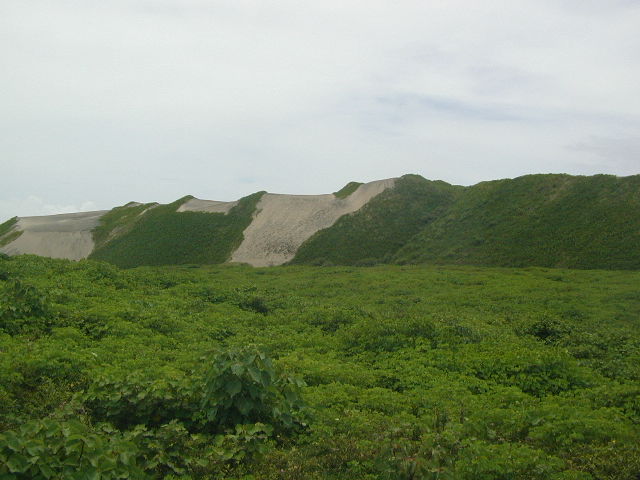
Of course, that meant a steep climb up the dunes. There was a switchback part of the way to help but, frankly, I was more or less dragged up the last section. Fortunately, the view from the top was worth the effort. I'd probably have appreciated it even more had I been feeling better overall.
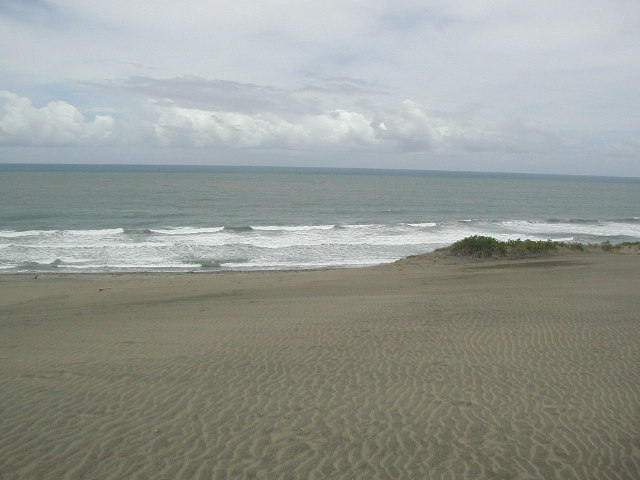
By the second Friday night I was recovered enough to have the energy to take photos. As usual, the evening began with lots of kava drinking for those who chose to indulge. One of the other people on the dig, Jack (whose father is an old friend of Paddy's) really got into the spirit of things and helped in making the kava.
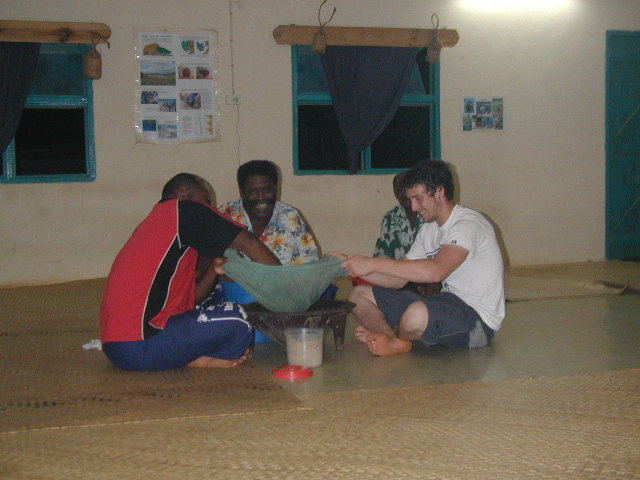
The more formal entertainment began after dinner. There was the inevitable dusting with baby powder first. Then the children of the village performed dances for us - first the boys, then the girls. The girls were well rehearsed, but the boys were a bit lost
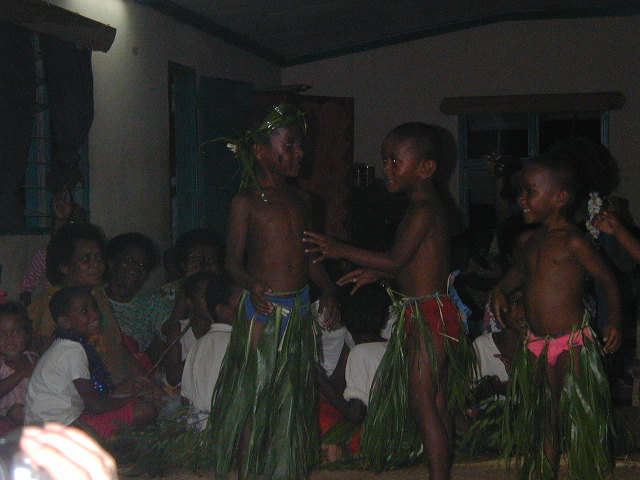
I was, again, using my odd digital camera with the built-in Polaroid printer. Polaroid 500 film is, alas, no longer made (and I have read that all Polaroid film will stop being manufactured in the near future), but I had enough of a supply with me to allow me to give out prints to many people, making people eager to be photographed. I think I got some particularly good shots of some of the village women and here are a few of them.
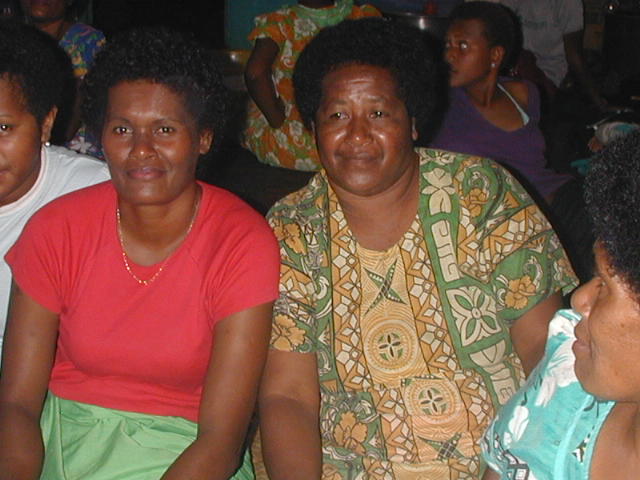
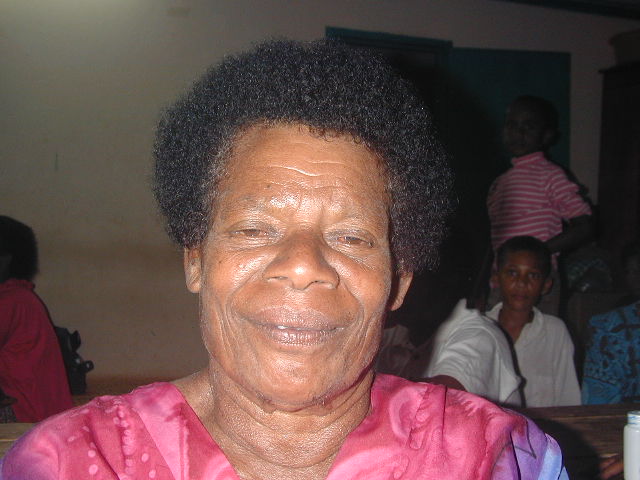
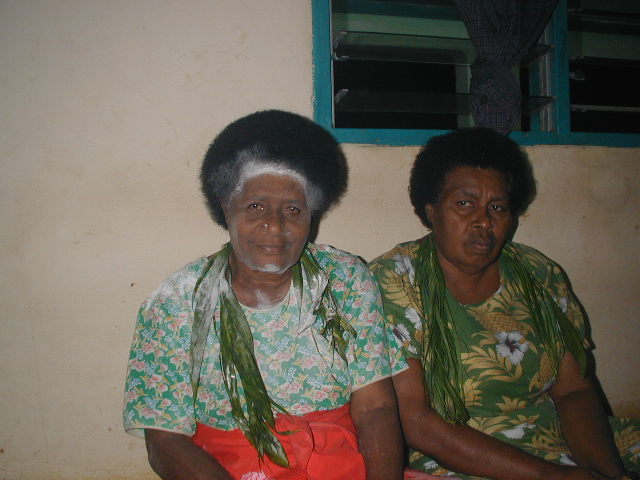
We knew our final evening at Vusama would involve a bit of a party. Rachel and I had seen Sareanna making floral leis, which we were duly presented with. In turn, we presented our gifts of t-shirts from our homes to the family.
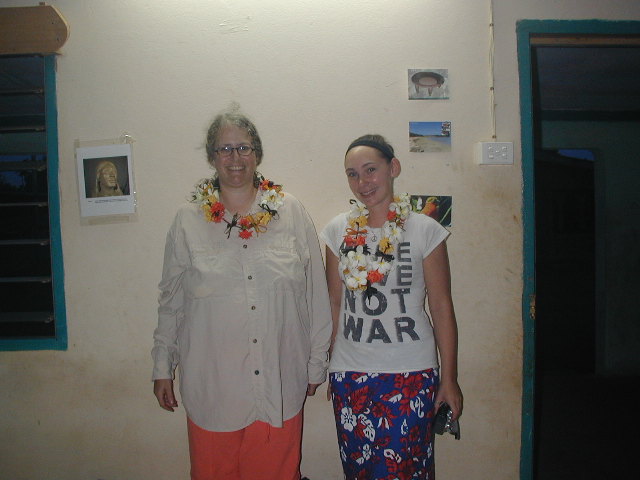
Before dinner, there was a kava ceremony, essentially asking permission for our departure. Dinner was something of a feast, with lovo food, cooked in a pit over hot coals. That was followed by dancing to the same three or so CDs played over and over on the boom box. I would make a snide comment but somebody would probably point out that I've been known to play the same song over a dozen or more times in a row.
In the morning, we took some final family pictures.

Then we went down to the Community Hall for breakfast and goodbyes. A bus took us back to the Hotel Mercure in Nadi, where Paddy was busily greeting the next group of volunteers. The flight schedule meant that we all had a long day to kill, but I'll talk about that in the final chapter.
[ Back to Previous Chapter | Back to Index | On to Next Chapter ]
last updated 24 February 2008